The Ultimate Guide to Creating a High-Impact Email Marketing Strategy
Published on December 06, 2024/Last edited on March 12, 2025/19 min read
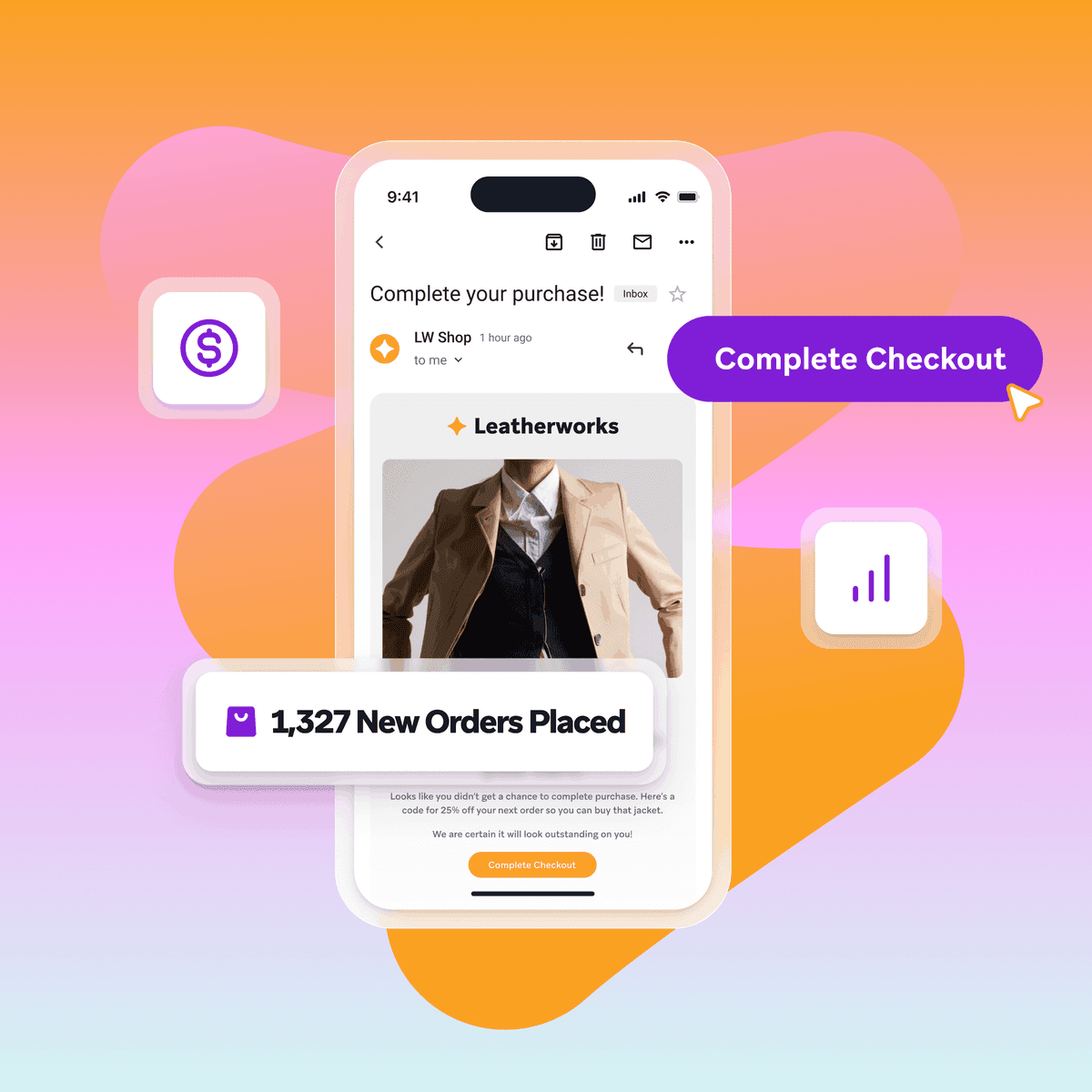

Team Braze
Email marketing is one of the original forms of digital messaging and offers strong returns on investment. Dependable and effective, it is a powerful way to reach, engage and convert an audience.
Most of us email on a daily basis. Despite the growth of chat apps, mobile messengers, and social media, email remains incredibly popular. In 2022, there were 4.26 billion email users worldwide and that number is set to grow to 4.73 billion users by 2026. For all its simplicity, it could be argued that email is the strongest currency of the internet: Exchanged for so many reasons (information, offers, community and purchasing, to name a few), an email address can have wide reach and incredible gains.
So how can a business truly make the most of email to connect with their customers? In this article, we’ll talk about why having an email strategy is important, how to ensure that strategy is set up to succeed over the long haul, how you can measure its effectiveness, and showcase some examples of successful strategic campaigns for your inspiration.
Table of contents
- What is an email marketing strategy?
- Why is having an email marketing strategy important?
- What’s the difference between an email marketing strategy and a customer engagement strategy?
- 5 metrics to track as part of your email marketing strategy
- 7 AI tools to improve your email marketing strategy
- 2 examples of customers successfully leveraging an email marketing strategy
- Finding the right technology to support an email marketing strategy
- Final thoughts
- Email marketing strategy FAQs
- Email marketing strategy resources
What is an email marketing strategy?
An email marketing strategy is a plan and process that helps marketers to reach their desired audience effectively via—you guessed it—email. It sets out, in detail, what emails to send, how many, to who and when. Doing so helps a business achieve their desired result in the most effective and efficient way.
The process typically entails:
1. Setting goals and how you will measure them
Having well-defined goals makes it easy to see if your campaign—or your overall email program—is effective. It’s the best way to really get to know your audience, find out what works and what doesn’t and strengthen the strategy.
These goals also serve to align teams and broader business needs, guaranteeing that there are common, shared objectives across the company.
2. Researching your target audience
If you want consumers to connect with your brand, then understanding your audience and personas is key to making that happen. The more you can segment your emails, the better chance you have of making that connection and understanding what it is your audience wants the most.
3. Reviewing your internal data—if you have it
If you can identify patterns or trends, you’ll enhance the precision with which you target, position and personalize your emails, so reviewing your internal data, if you have it at this point, is essential. For example, if you have sales data that indicates a certain kind of customer tends to buy product X around Y timeframe, you can leverage that knowledge to send more relevant emails.
4. Segmenting
A personalization tool, or better still, a consumer engagement platform can help to segment your audience and deliver more personalized messaging. Do some members of your audience engage better in the morning? Do some not want to hear about sales? Would it be beneficial to highlight certain offers to people in a particular area? The more information you have, the more relevant you can make your emails to the people receiving them.
5. Integrating to a marketing calendar
Integrating your email plan to the larger marketing calendar means that you can plan, distribute and track with better accuracy. Your business might leverage coordinated themes and campaigns where all the messaging aligns, allowing you to see how a customer might be engaging with that program at any point in time. You also want to make sure that you are aware of any national holidays, awareness days, and events, since some of these days could be an opportunity for a targeted campaign, while others may be important to avoid for sensitivity or optics reasons.
6. Designing and crafting your emails
Designing and crafting the ideal email can do a lot to encourage recipients to open it. From writing the most enticing subject line to the way images are positioned, or the colors used and tone of voice, these efforts can help to uplevel the messages you send in this key channel, supporting increased loyalty and brand awareness.
Why is having an email marketing strategy important?
There are many benefits to having an email marketing strategy. Aside from taking the guesswork out of what to send and when, it can make it easier to reach your marketing goals while building deep relationships with your audience. After all, emails don’t have to be transactional; ultimately, they’re tools to connect with your audience and get to know them, serving up personalization that strengthens that customer/brand bond and helps earn your company a place in consumers’ hearts and minds.
You’ll also find that an email strategy is advantageous because it makes it easier for you to:
Create personalized content
No one wants to read an email that sounds like it was sent to everyone on earth. With email, personalizing your outreach can be as simple as including the subscriber’s first name. That said, the more data you gather about your audience, the more you can personalize. By creating content that speaks directly to them, on a one-to-one basis, your customers will feel more connected to your brand.
Direct the path of your audience
Your brand might be completely online, or you might have a physical store (or multiple stores). Either way, getting people to engage where you want them to can be a struggle. An email strategy can incorporate tactics that help to direct the path of your audience. Want to highlight a particular store to nearby customers? You can. Want to focus on a specific product or service? You can! Emails can generate traffic to the right places and, even better, to the right products. In fact, the more precise you can be, the easier you’ll make it for your customers to take key actions.
Be cost effective
Email marketing typically has a high return on investment (ROI), so it’s the perfect option for businesses that need to drive a lot of impact from their marketing budget. Although it varies by industry, the average ROI for email marketing is 42:1. What’s not to love about that?
Improve retention
Improving loyalty and retention is a key goal for any business. Whatever else they do, you always want your customers to come back again. Email is a powerful way to cultivate that loyalty and reduce churn by adding value, even when customers aren’t making a purchase. Whether it’s offering discounts, early access to sales, a rewards program, information they can use, or even just sending something fun that makes them laugh, continually providing value for your customers will not only keep them loyal but also turn some of them into advocates and increase brand awareness.
Drive awareness and product discovery
Promoting your brand to new people comes with its own set of challenges. It can be costly and less effective if you don’t know exactly who you’re talking to and messaging people who aren’t expecting to hear from you can even drive some people away. But with your email list, you have a group of people who have told you they are interested in what you have to say. So whether it’s new features, products or services, new content or the latest deal, your success rate with the messages you send is likely to be higher.
Save time
Automation is a time saver when it comes to emails. Within your email marketing strategy, setting up workflows that are triggered when subscribers take specific actions, means that messaging sequences can be planned and created in advance and executed if and when the customer’s behavior triggers it. And with these planned emails running in the background, you have more time to focus on other areas of your marketing plan.
Get immediate results
Email is one of a few key marketing methods that can drive comparatively quick results. Compared to other marketing strategies that may take weeks or months to see results, emails deliver pretty swiftly, allowing you to nudge customers to take high-value actions like making a purchase with little delay. They’re easy to track and they provide actionable insights too.
Align to support highly relevant campaigns
Email is likely only one component of your marketing plan. However, with a clearly thought-out strategy, you can ensure it is aligned with other channels being used in your campaign so that the messaging is comprehensive and consistent. The aim is to provide a seamless experience for customers, one that is highly relevant to them. To do that, it’s important to focus on breaking down the silos that exist within your business so that cross-channel, multi-channel or omni-channel approaches can be harnessed with maximum results.
Have control of your data
The more you can move away from relying on third-party data and gather first-party data, the better. And email is a great way to do that. Tapping into your unknown customers and finding out more about them allows you to get closer to your audience, which in turn reaps benefits for your brand. But in order to achieve that, you need to become more data independent.
First-party data provides key insight regarding how customers are engaging with your brand. This type of data can be leveraged in compliance with privacy laws, as it is collected directly from the user , which allows you to inform users about this data usage and/or ask for their consent as required. In comparison, third-party data is often collected by outside parties and then sold to brands, usually without the user’s knowledge or consent (and often in conflicts with privacy legislation). By leveraging first-party data in connection with your email and general customer engagement efforts, you can make it easier to comply with key laws and respect your customers’ preferences without sacrificing personalization and the relevant experiences they crave.
Have clear success criteria
With a well-designed email marketing strategy, you can reduce the uncertainty associated with your email campaigns and not only plan what to say in your messages, but also set clear success criteria, too. With a test-and-learn approach, you can continually review, adjust and improve your campaigns based on the data you receive, in real time.
Have access to the best tools
To efficiently gather actionable data, build campaigns, and iterate on relevant insights, you need to have access to best-in-class tools. Customer engagement platforms like Braze now enable you to leverage all of your data to support your email and overall customer engagement program, either by ingesting data directly into their platform, or by integrating with your data warehouse. Then, with this centralized bank of data, you can take advantage of AI and Machine Learning (ML) to predict what customers will do (and need) next, allowing you to truly make the most of your campaigns.
Increase revenue
Emails drive customers towards purchases in direct ways (such as highlighting purchases) and less direct ways (such as adding value, rewards programs, surveys and feedback). Even order confirmation and subscription confirmation emails have a part to play in building the relationship between customer and brand and can be extremely effective at boosting customer lifetime value (LTV), especially for seasonal events and product launches.
What’s the difference between an email marketing strategy and a customer engagement strategy?
An email marketing strategy focuses purely on the channel of email. A customer engagement strategy in comparison looks at all the platforms where a brand and audience might engage and interact.
While it’s important to have an email marketing strategy, it's equally important to have a holistic customer engagement strategy that works across all of the channels that you need it to. That might include email, social media, WhatsApp or any number of other platforms where your audience is. Each channel should have its own strategy, to address the specific challenges and opportunities that are unique to that channel, but with an eye toward providing a seamless, coordinated experience for each end user no matter where they engage.
5 metrics to track as part of your email marketing strategy
Assessing the impact of your email marketing campaign means paying attention to the meaningful metrics that ensure long-term success. Here are five key metrics to watch:
1. Non-open rates
The open email rate is not as significant a factor as it once was, thanks to the launch of Apple’s Mail Privacy Protection (MPP) feature in 2021. This inflates the number of email opens, making it hard for marketers to know how seriously to take this metric. Instead, you should look at the number of people who DID NOT open your email. You can take this non-open rate as an indicator of the comparative reach of different email campaigns you send and a guide towards deeper investigation.
2. Email click rates
For a top-level look at channel performance, email click rates show you when an email recipient takes action by clicking a link within the message they receive. It isn’t inflated by MPP and can be used to see the level of engagement that each email is getting. There will be some natural variation. A newsletter with a lot of strong CTAs will likely have a higher click rate than a transactional email, so be careful not to rule out a certain type of email because it didn’t drive many clicks, when that wasn’t the intention for it anyway.
3. Email bounce rates
Emails that don’t reach their intended recipient are essential to note when investigating reach. Hard bounces are usually associated with nonexistent email addresses and if you’re finding you have a high hard bounce rate, it’s time to look at your email hygiene.
A soft bounce is down to temporary problems, such as a full inbox or an email that’s just too big. These aren’t as concerning, but do provide useful information into why certain types of messages might not be getting through.
4. Email complaint rates
There are multiple ways that someone can register their disinterest in your emails. Many brands now allow customers to opt out of certain types of email or unsubscribe altogether. Despite this, many people will just mark an email as spam, which is in effect an email complaint. It not only prevents messages from getting through to that individual in the future, since they’ll likely land in their junk or spam folder, but it can also damage your overall email reputation, leading even some highly engaged customers to see fewer of your messages. For this reason, keeping an eye on your complaint rate can be crucial for monitoring the overall health of your email program.
5. Email conversion rates
Each email should have a conversion goal set. Why are you sending that specific email? What action do you want a user to take? The conversion rate showcases what percentage of the people who received a given message took the action you were looking to drive. Tracking this metric allows you to see if your emails are supporting the overall goals of your email and customer engagement strategy. If the conversion rate is low, you know you need to review and adjust your sends in order to deliver more effective emails in the future.
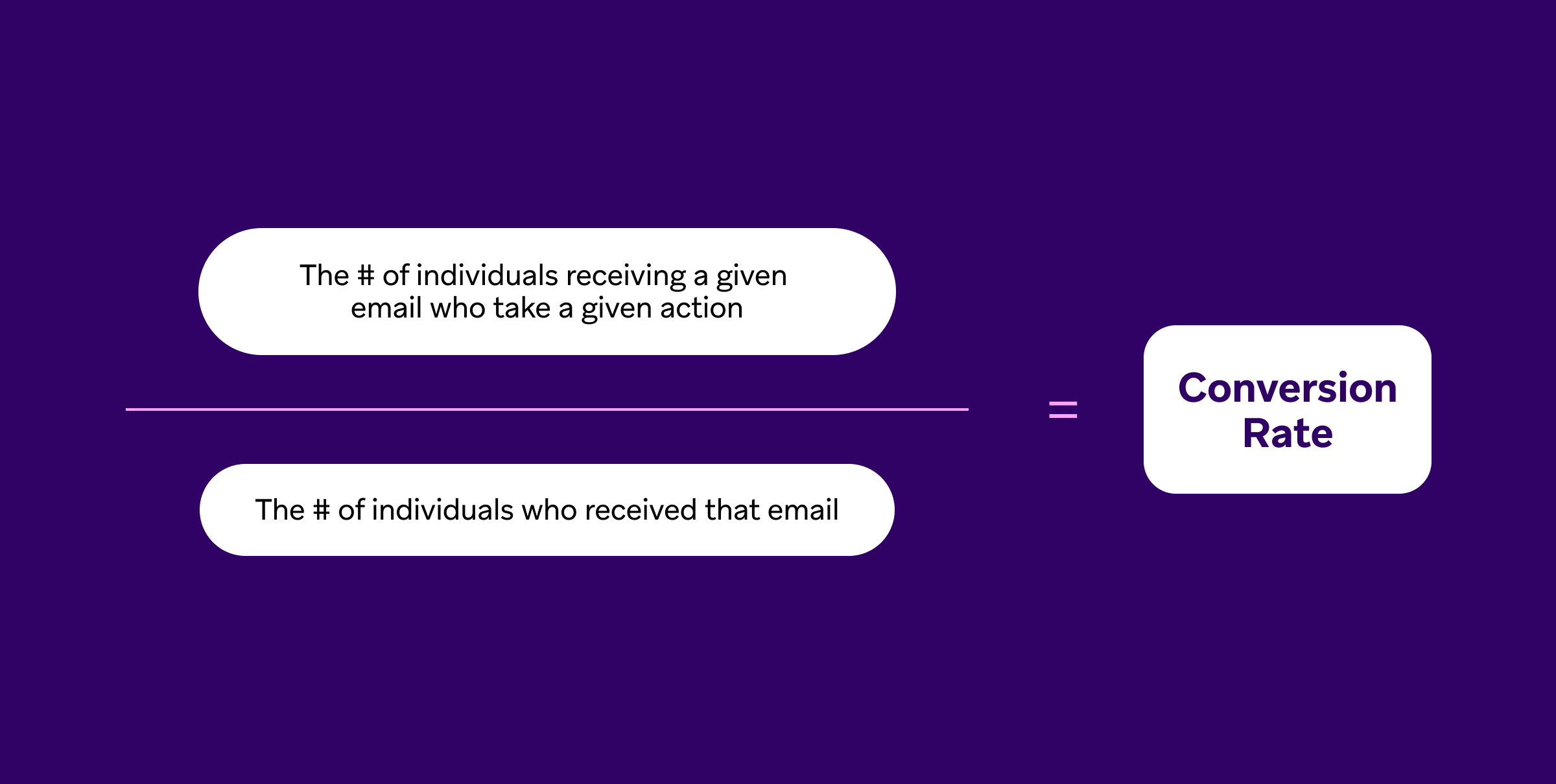
7 AI tools to improve your email marketing strategy
Have an email marketing strategy in place but looking to take it up a notch? Here are examples of some tools that can help!
1. AI Copywriting Assistant
The Braze platform’s AI Copywriting Assistant natural language generation tool—powered by ChatGPT—makes it easy to spin up copy, including multiple versions of subject lines, CTAs, and more. Additionally, with the AI Copywriting Assistant’s Tone Control feature, you can decide the exact tone of the message that you are looking to generate.
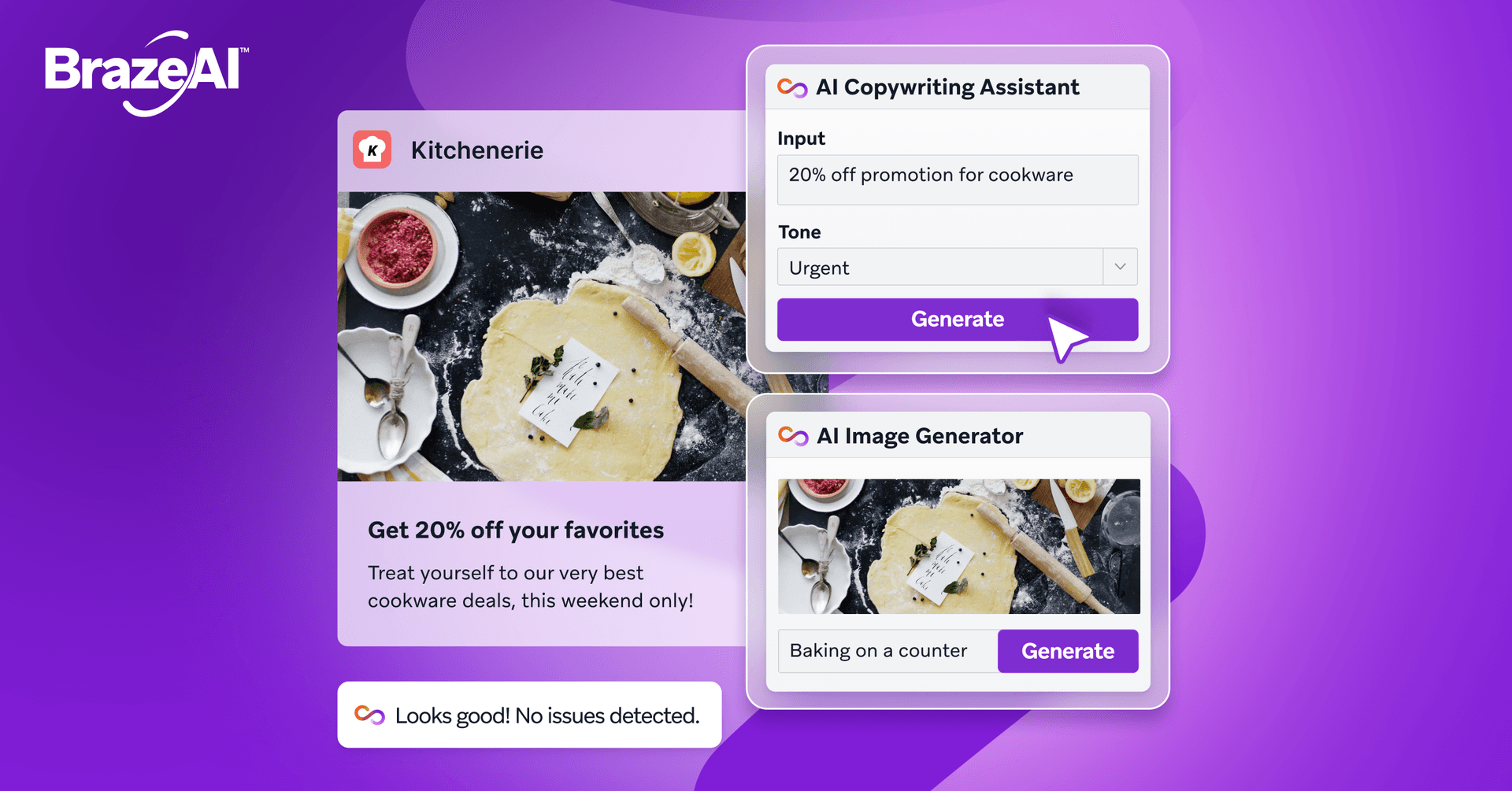
2. AI Image Generator
The Braze AI Image Generator, built on OpenAI’s DALL·E 2, can give marketers a competitive advantage by empowering them to quickly advance from ideation to action when it comes to campaign visuals without relying on (or waiting for) overburdened creative teams.
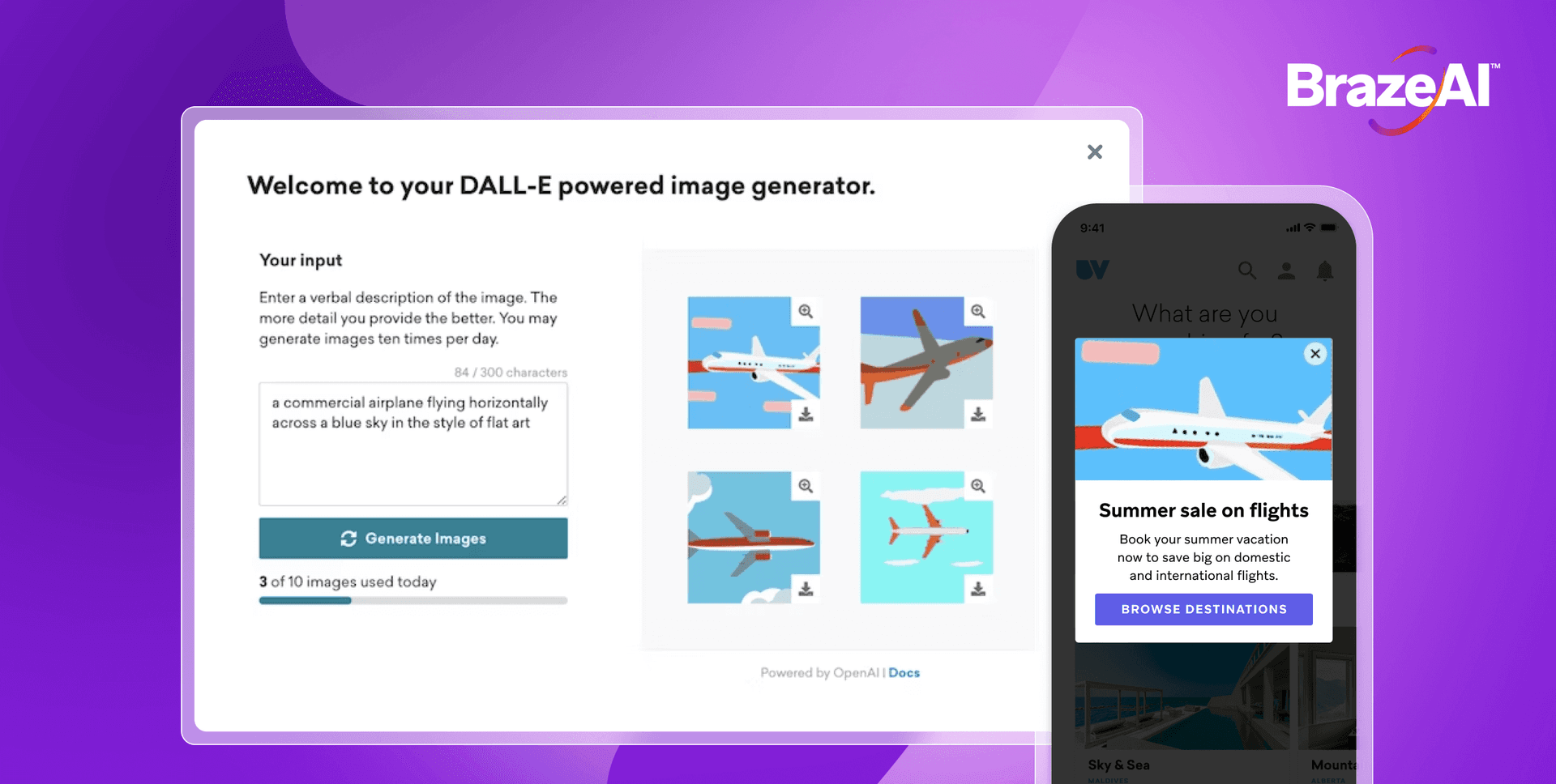
3. AI Content QA
Tasks like checking for grammatical errors or inappropriate content can be made easy with the Braze platform’s AI Content QA tool, opening up bandwidth for your team to focus on strategy instead.
4. AI Item Recommendations
The Braze platform’s AI Item Recommendations feature is designed to allow brands to surface the next best product, content, or items in ways that are personalized to every customer at scale. Easily plug intelligent recommendations into your emails—or into campaigns on any channel—to help customers find more value from your brand.
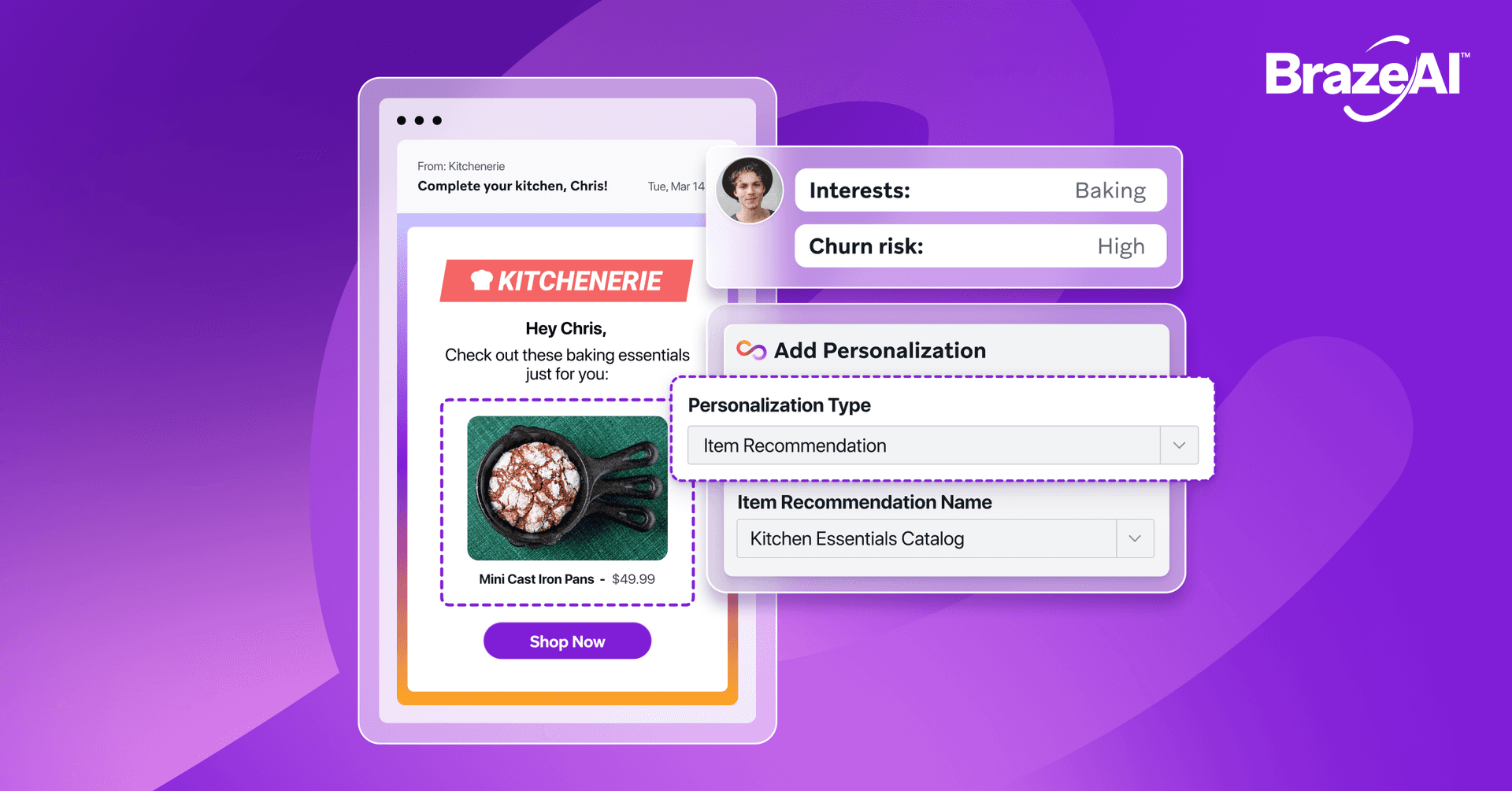
5. Personalized Variant
Braze Personalized Variant allows marketers to adjust which email (or other message) variant a given customer receives, based on their unique behaviors, preferences, and attributes. This feature supports more relevant, customized experiences, potentially increasing engagement and conversions.
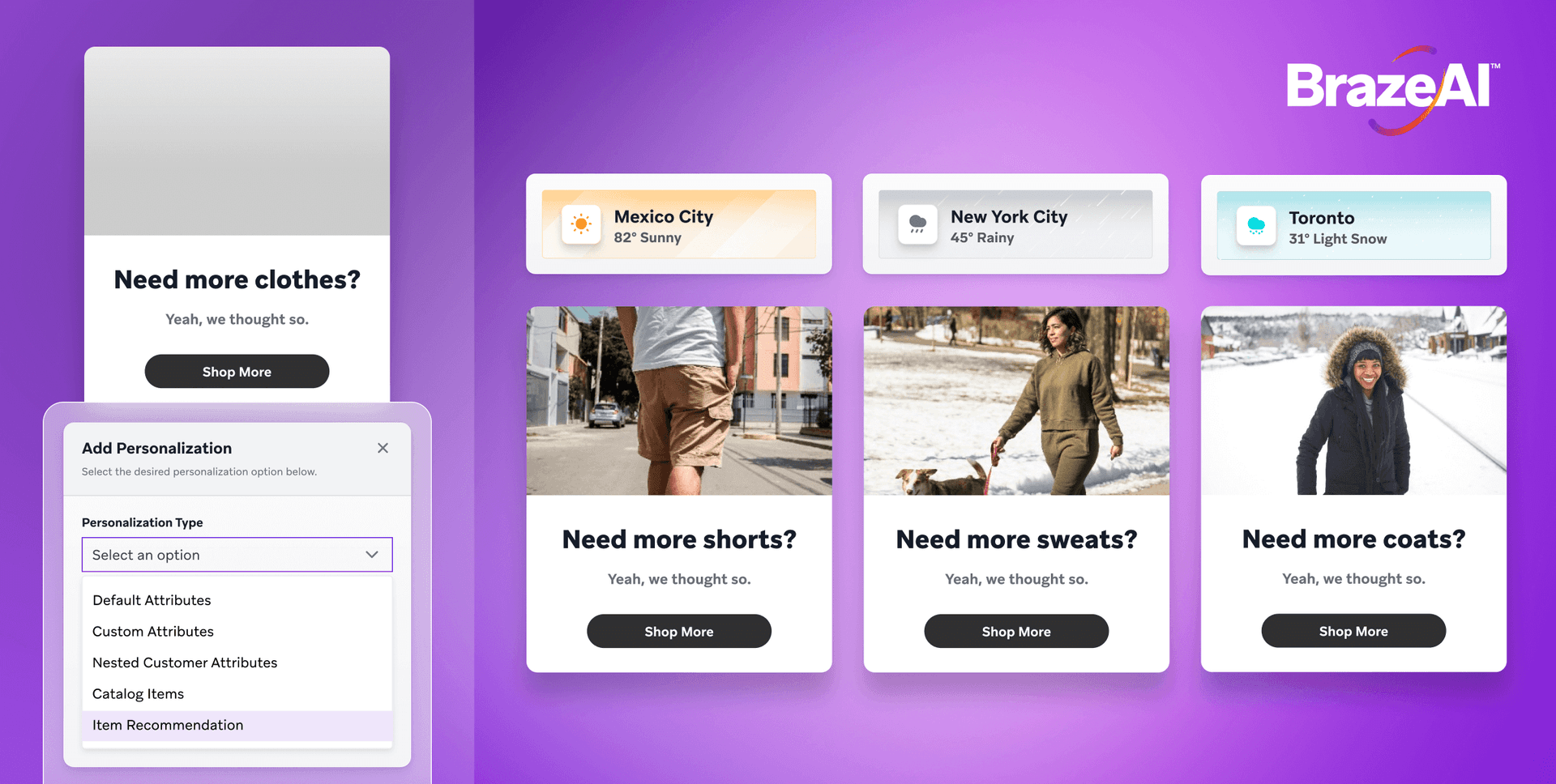
6. Personalized Paths
Personalized Paths help facilitate true personalization at scale. This feature automates journeys to provide each customer with the message copy, creative, channel, offer, and more they’re most likely to engage with at every stage of a journey—all with a simple toggle.
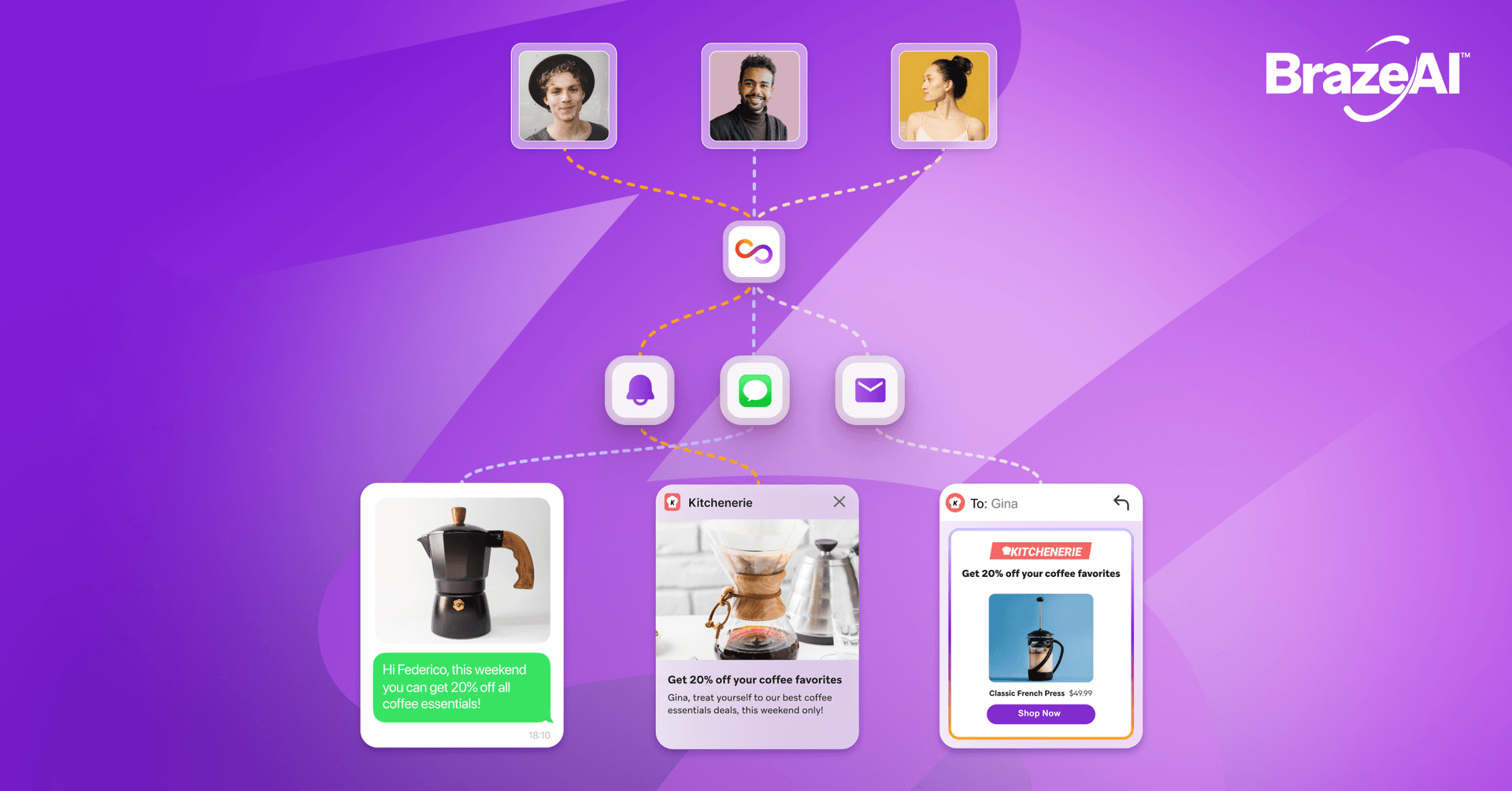
7. Intelligent Timing
Solutions like Braze Intelligent Timing help send customers messages that reach customers when they want to hear from your brand. So, if your customer is active in the mornings or prefers to engage at night, you can rest easy knowing they’ll receive your email when they are most likely to see it and take action.
2 examples of customers successfully leveraging an email marketing strategy
So what exactly does a successful email marketing strategy look like? Here are three examples to help inspire you.
How BlaBlaCar used smart testing to boost open rates by up to 24%
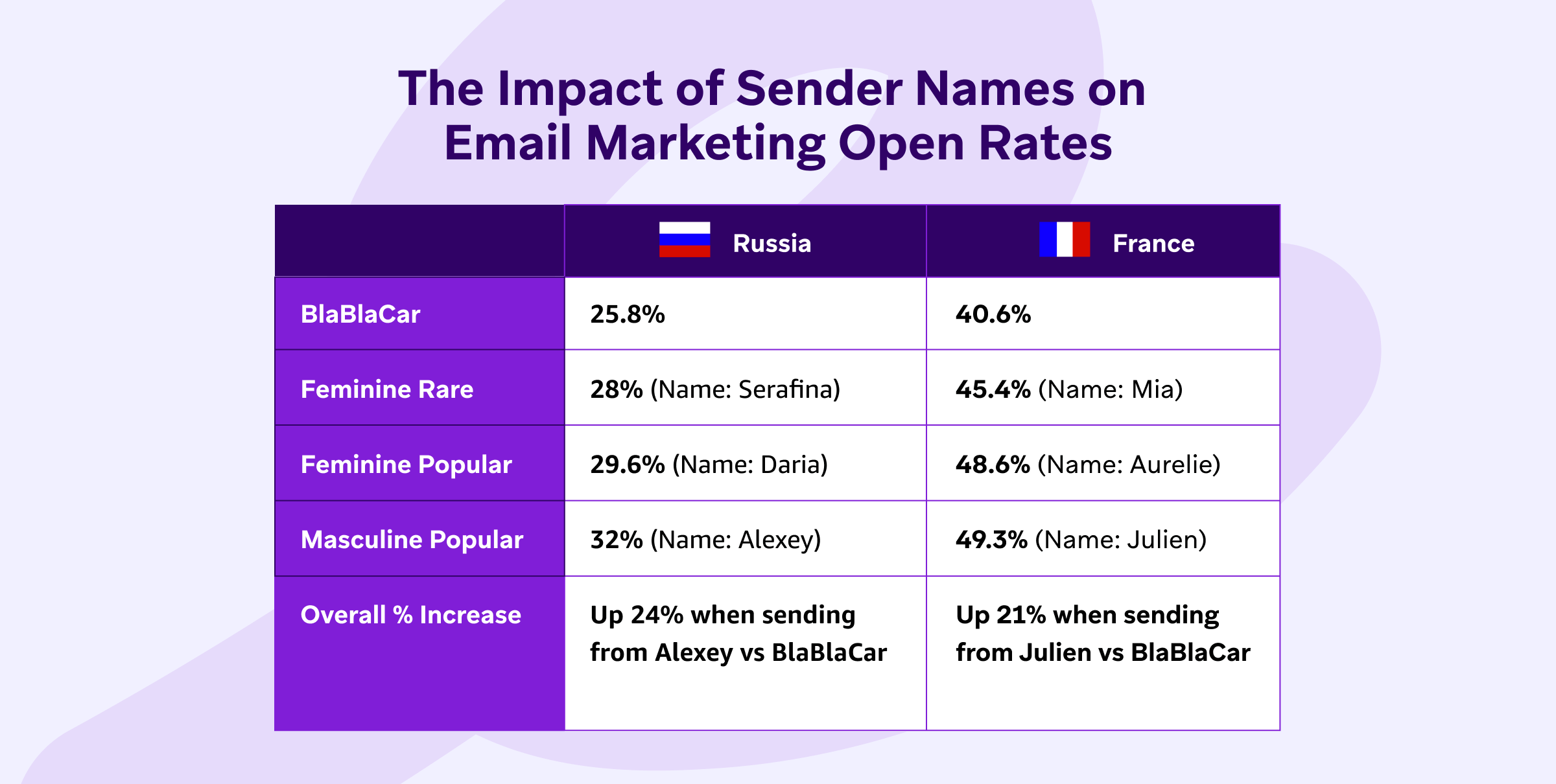
Problem
French carpooling platform BlaBlaCar wanted to reach its customers as effectively as possible via email while also maximizing its email open rates.
Strategy
BlaBlaCar created a marketing hypothesis that they wanted to test.
- Hunch #1: That email recipients would be more likely to open a message that was listed as coming from a person’s name
- Hunch #2: That different types of sender names would perform better in different countries.
They used Braze Canvas to automate and simplify the process of testing the two hypotheses. With this tool they could visualize the customer journey and find it easier to conceptualize their campaigns. From here they were able to seamlessly coordinate targeted, personalized messages across channels. Over the course of two months, the Braze platform made it possible to build out testing flows over several rounds of related experiments in two of its markets—France and Russia.
Results
The results proved that both hypotheses were correct. BlaBlaCar discovered that using the first names of real people as the email sender resulted in 20+% higher open rates for their messages, compared to emails sent from “BlaBlaCar.” They also found that gender and name popularity had an impact on open rates, with a popular masculine name proving to be most popular both in Russia and France.
Canva uses Braze Catalogs to create personalized messages that drive new feature adoption
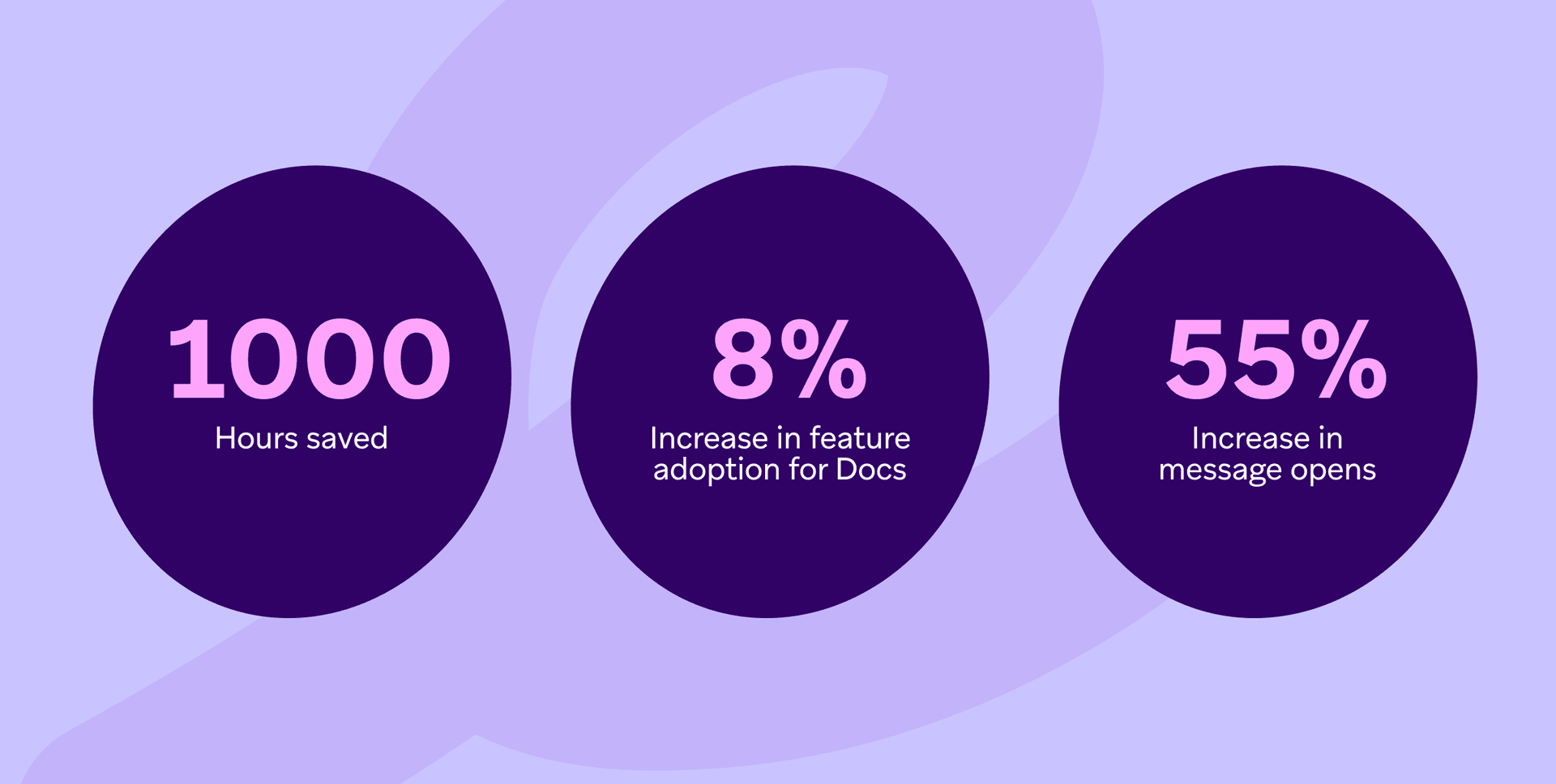
Problem
Canva wanted to update its feature adoption communication flows to surface relevant features that supported both a better design experience and increased user stickiness. The team also wanted to create a structure to easily and quickly update messages for new feature launches.
Strategy
Using Braze Canvas and Braze Catalogs, Canva was able to create 650+ unique campaigns that better surfaced more than 75 key product features that were personalized to each user.
Results
With this campaign, Canva increased message opens by 55% and clicks by 47%. They also increased featured adoption by up to 8%, which had a downstream impact on use retention and revenue. In addition, the team increased their operational efficiency, saving about 1,000 hours of production time using Braze while optimizing for 25 features with 200+ variants.
Finding the right technology to support an email marketing strategy
When it comes to sourcing a customer engagement platform like Braze to help you fulfill your email marketing needs, what exactly should you be looking for?
1. Data agility and customer journey orchestration
In this context, orchestration refers to the ability to create a connected customer experience and a single unique view of the customer by bringing together data from multiple platforms or sources. If you have multiple data sources at your disposal, you’ll need to make sure that you can pull that data into a single platform or support the ability to take action on data from other technologies (e.g. sending campaigns in your customer engagement platform based on segments held in your data warehouse)..
2. Ability to A/B test and easily optimize messaging
Understanding what powers your business, what’s working, what’s not, and when to scale, comes through testing and optimizing. A platform that allows you to continually test, review and adjust will enable you to make more impactful data-driven decisions and to stay ahead of the curve.
3. Dynamic segmentation and real-time analytics
Tracking and coordinating the insights from your emails help to further personalize a customer’s experience can have a powerful positive effect on your customer relationships and bottom line. But it’s normal for audiences and their behaviors and preferences to change over time, creating a challenge for marketers. With dynamic segmentation and real-time analytics that populate and update in real time based on the subscriber behaviors, brands can gain an in-the-moment understanding of their audience and use it to provide timely experiences to each individual user.
Final thoughts
Email marketing shouldn’t be underestimated: It’s a foundation of modern customer engagement and the best results come with a solid foundation.
The future of email is already here, with ML and AI enhancing a brand’s ability to customize the consumer experience. As we embrace this new technology and work to establish familiarity with customers without feeling intrusive, making sure that we put in the time to humanize interactions with users is key.
There are many benefits of email marketing, as long as you have the right approach and the right tools at your disposal. Looking to take your email program to the next level? Check out the Braze platform.
Featured email marketing strategy resources
Email marketing strategy FAQs
An email marketing strategy is a plan and set of actions that marketers follow to achieve a desired goal or goals for their emails.
There are generally 4 types of email marketing campaigns that you may come across regularly.
- Transactional emails are emails that are triggered by a customer’s action and are used to give information about a specific transaction (e.g. a purchase confirmation).
- Promotional emails encourage subscribers to make a purchase or sign up for a subscription. They may offer discounts or special deals.
- Email newsletters are used to share important info, news or trends, new products or events. They will usually drive traffic to the website.
- Retention emails are there to foster trust and loyalty. They aim to keep your customers engaged with your brand and products or services—for instance, Thank you or feedback emails are common retention messages in this channel.
To build an effective email strategy, follow the basic steps outlined in this article.
- Set your goals and how you will measure them
- Research your target audience
- Review your internal data if you have it
- Segment your audience
- Integrate your email sends with your marketing calendar
- Design and craft your emails to make them more compelling
The extent of success is dependent on the industry and how well your email strategy is executed, but email remains one of the most effective marketing channels, boasting an ROI as high as 42:1.
The first step in an email marketing strategy is setting a goal. This should clearly state what you want a campaign to achieve for your business. It will help guide you through the process and make important decisions along the way.
Related Tags
Be Absolutely Engaging.™
Sign up for regular updates from Braze.
Related Content
View the Blog
The new inbox reality: How iOS changes are reshaping email marketing

Aparna Prasad

Experience optimization: Turning data insights into better journeys

Team Braze

December 2025 Bonfire Marketer of the Month: Jagex’s Emma Oliver
